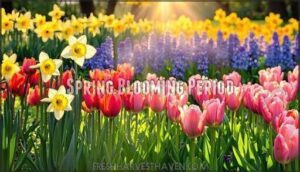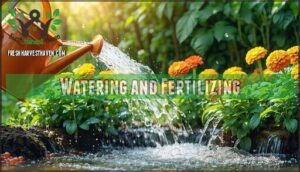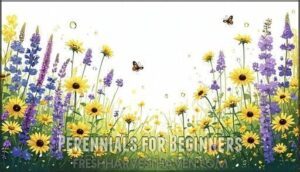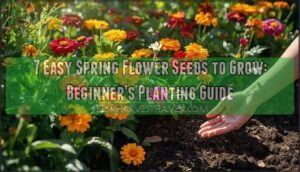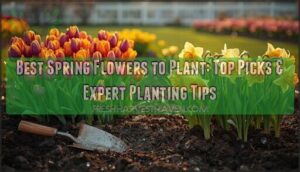This site is supported by our readers. We may earn a commission, at no cost to you, if you purchase through links.
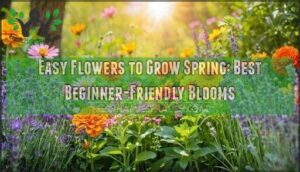
Pansies handle cool spring weather like champs, while petunias burst with color all season long. For perennials, try black-eyed Susans or lavender – plant once, enjoy for years.
Most need well-draining soil and regular watering until established. Sweet alyssum and cosmos self-seed, creating next year’s garden without extra work.
These blooms attract beneficial pollinators too, turning your space into a buzzing haven. The secret lies in matching flowers to your specific conditions and timing.
Table Of Contents
- Key Takeaways
- Easy Spring Flowers
- Spring Blooming Period
- Planting Spring Flowers
- Pollinator Friendly Flowers
- Beginner Friendly Flowers
- Frequently Asked Questions (FAQs)
- What is the easiest flower to grow in spring?
- What is the easiest flower to grow for beginners?
- What is the fastest growing spring flower?
- What is the easiest flower to plant and keep alive?
- What are the most low maintenance flowers?
- Which spring flowers bloom the longest?
- What flowers are easy and cheap to grow?
- Which spring flowers thrive in shaded areas?
- What spring flowers are drought tolerant?
- What companion plants work well with spring flowers?
- Conclusion
Key Takeaways
- Start with foolproof annuals – Plant marigolds, zinnias, and sunflowers that forgive beginner mistakes and practically grow themselves with minimal care
- Choose flowers that match your timing – Plant pansies for cool spring weather, wait until after the last frost for tender varieties, and start seeds indoors 6-8 weeks early for best results
- Pick low-maintenance varieties – Select drought-tolerant options like cosmos and black-eyed Susans that self-seed and require minimal watering once established
- Create pollinator-friendly displays – Combine colorful blooms like petunias and marigolds that attract bees and butterflies while providing months of continuous color
Easy Spring Flowers
Starting your spring garden doesn’t have to be complicated when you choose flowers that practically grow themselves.
These beginner-friendly blooms will reward your efforts with vibrant colors and minimal fuss, making your first gardening season both successful and enjoyable.
They will provide you with a minimal fuss gardening experience.
Low Maintenance Options
Transform your garden into a low-maintenance haven with drought-tolerant blooms that practically care for themselves.
These pest-resistant plants handle spring’s unpredictable weather while delivering stunning color without constant attention.
- Freedom from daily watering – drought-tolerant varieties thrive on neglect
- Pest problems vanish – naturally resistant plants mean fewer garden headaches
- Self-seeding flowers return – your garden keeps growing without replanting
- Minimal deadheading required – spend weekends enjoying, not maintaining
Choose coneflowers, black-eyed Susans, and cosmos for beginner flower gardens that flourish with basic care and no fertilization needed.
Pansies and Petunias
Pansies and petunias shine as top picks for your beginner flower garden. These spring bloom flowers adapt beautifully to container gardening and hanging baskets, making them perfect starter choices.
Here’s your success strategy:
- Choose vibrant pansy colors like purple, yellow, and orange for instant charm
- Select petunia varieties such as Wave or Grandiflora for different growing habits
- Take advantage of pansies’ frost tolerance for early spring planting
- Use hanging baskets to showcase trailing petunias’ cascading beauty
- Practice regular deadheading to keep these easy spring flowers blooming longer
Both thrive with minimal fuss and reward you with months of colorful displays. To guarantee the best growth, remember to monitor local frost dates for perfectly timed plantings.
Marigolds and Zinnias
Looking to brighten your garden? Marigold varieties span sunny yellows to deep oranges, while zinnia colors dazzle in vibrant reds, pinks, and purples.
These easy spring flowers excel at companion planting, naturally repelling pests with their built-in pest resistance.
Their impressive drought tolerance means less watering for you.
Perfect beginnerfriendly blooms for spring flower gardening—simply plant marigolds and zinnias in full sun, then deadhead spent flowers to keep the show going all season long.
Sunflowers and Cosmos
While marigolds bring cheerful colors to your garden beds, sunflowers and cosmos create stunning vertical displays that’ll make your neighbors stop and stare.
These easy to grow blooms thrive with minimal fuss in your spring flower gardening adventures.
Sunflower varieties like Mammoth reach eight feet tall, while delicate cosmos colors range from white to deep pink.
Try companion planting these beauties together for maximum impact.
Both make excellent cut flower choices, and seed saving guarantees you’ll enjoy these spring flowers for years to come.
Spring Blooming Period
Understanding when different spring flowers bloom helps you plan for continuous color throughout the season.
You can enjoy early daffodils in late winter, followed by tulips in mid-spring, and finish with fragrant hyacinths as temperatures warm up to achieve continuous color.
Early Bloomers Like Daffodils
Daffodils kick off spring’s flower show with their cheerful blooms appearing as early as late February. These easy to grow blooms need minimal fuss and reward you with years of reliable color.
Daffodils light up the garden with bright, carefree blooms that signal spring’s joyful arrival year after year.
Key advantages of daffodils include:
- Natural pest control against deer and rabbits
- Self-multiplying bulbs for expanding displays
- Hardy performance in USDA zones 3-8
Plant bulbs at proper planting depth (6 inches) in fall for best sunlight needs fulfillment. Popular daffodil varieties like ‘King Alfred’ pair beautifully with other spring flower types as perfect companion plants.
Mid-Season Bloomers Like Tulips
When spring hits its stride, tulips steal the show with their classic cup-shaped blooms and rainbow of colors.
These spring flowers perform best in well-drained soil with Planting Depth at three times the bulb’s height. Companion Plants like grape hyacinths create stunning displays, while proper Bulb Care and Pest Control guarantee healthy growth.
Hellebores, for example, offer blooms from January through April.
| Tulip Varieties | Height | Bloom Time |
|---|---|---|
| Darwin Hybrids | 24-28 inches | Mid-spring |
| Triumph Tulips | 16-20 inches | Mid-spring |
| Single Late | 18-24 inches | Late mid-spring |
| Parrot Tulips | 16-24 inches | Mid to late spring |
Your spring planting guide should include these reliable spring flower varieties for foolproof results.
Late Bloomers Like Hyacinths
Hyacinths wrap up your spring garden’s grand finale with their intoxicating fragrance and jewel-toned blooms. These spring flowers deliver maximum impact for minimal effort, making them perfect for gardening for beginners.
Forcing bulbs indoors brings early color, while companion plants enhance outdoor displays.
- Hyacinth varieties like ‘Gipsy Queen’ create stunning purple waves across garden beds
- Fragrance profiles fill entire yards with sweet, honey-like scents that neighbors envy
- Post-bloom care involves simply cutting stems, letting foliage naturally fade away
- Easy to grow bulbs return yearly when planted in well-draining soil
- Spring blooms last weeks longer than tulips, extending your garden’s colorful season
Planting Spring Flowers
Successfully planting your spring flowers starts with understanding your garden’s unique conditions and timing everything just right.
You’ll want to prepare nutrient-rich soil, plant at the ideal time for your climate zone, and establish a consistent care routine that sets your blooms up for success.
Choosing The Right Soil
Think of soil preparation as laying the foundation for your flower garden’s success.
Start by testing soil pH levels—most spring flowers prefer neutral conditions between 6.0-7.0.
Focus on drainage needs by choosing well drained soil like sandy loam to prevent waterlogged roots.
Boost your garden soil with soil amendments such as compost, which adds essential organic matter.
These soil requirements create the perfect growing environment for vibrant blooms.
You can easily find a soil pH tester device to help with this process.
Planting at The Right Time
Once you’ve prepared your soil, timing becomes your secret weapon for spring gardening success. Getting your Seasonal Considerations right can make or break your flower garden dreams.
- Know Your Frost Dates – Check your Local Climate records to find the last expected frost, then wait 1-2 weeks before planting tender spring flowers outdoors.
- Start Seeds Smart – Begin indoor seed starting 6-8 weeks before your planting date to give seedlings a strong head start.
- Watch for Microclimates – Your sunny south-facing bed warms up faster than shaded areas, allowing earlier planting tips** in protected spots.
- Consider Flower Lifespan – Cool-season varieties like pansies handle light frosts better than heat-sensitive easy to grow** options like impatiens. For added protection, consider using garden frost blankets during unexpected cold snaps.
Watering and Fertilizing
After planting at the right time, watering frequency becomes your next priority.
Most spring flowers need one inch weekly, including rainfall. Fertilizer types like balanced 10-10-10 support healthy growth without excess foliage.
Watch for overwatering signs—wilted, yellowing leaves signal soggy roots. Easy to grow varieties like marigolds handle drought tolerance well.
For ideal root health, consider lukewarm water application. Apply spring gardening tips: water early mornings and check soil nutrients regularly for thriving blooms.
Pollinator Friendly Flowers
Choosing pollinator-friendly flowers transforms your garden into a buzzing ecosystem that supports essential wildlife while adding natural beauty to your space.
You’ll attract bees, butterflies, and hummingbirds with the right flower selection, creating a thriving environment that benefits both your garden and local pollinators.
Bees and Butterflies Favorites
Five spring flowers create butterfly and bee magnets in your garden.
Attracting bees becomes effortless with coneflowers and black-eyed Susans, while butterfly gardens thrive with cosmos and calendula.
These nectar sources support pollinator diversity year-round.
Marigolds serve as excellent larval host plants, giving butterflies safe breeding grounds.
Butterfly-attracting flowers like petunias complement spring flowers perfectly.
Plant these pollinator favorites together for maximum impact, creating buzzing ecosystems that’ll transform your garden into nature’s favorite restaurant.
Hummingbirds Attracting Flowers
Hummingbirds gravitate toward tubular shapes and bright flower colors like red cardinal flowers and coral honeysuckle.
These native species offer superior nectar richness compared to feeder alternatives.
Plant spring flowers such as bee balm and columbine for hummingbird-friendly gardens.
These easy to grow blooms support pollinators while attracting bees too, creating vibrant ecosystems in your yard.
Pollinator-friendly flowers, such as those discussed in the article about attracting pollinators, are essential for ecosystem health.
Planting for Pollinators
Since creating butterfly gardens starts with strategic plant selection, focus on native plants that attract bees and other pollinators naturally.
Mix hummingbird blooms like petunias with butterfly attracting flowers such as coneflowers and zinnias.
You can also find specialized flower products designed to further attract these creatures.
This approach promotes pollinator diversity while keeping your spring flowers easy to grow and maintenance-free for beginners.
Beginner Friendly Flowers
You’ll find success with beginner-friendly spring flowers that practically grow themselves with minimal fuss.
These hardy varieties forgive watering mistakes and soil imperfections while delivering gorgeous color that’ll make your neighbors wonder how you got so good at gardening.
They are hardy varieties that can thrive with minimal care, making them perfect for those new to gardening.
Easy to Grow Annuals
Annual flowers become your gardening allies, delivering instant color without long-term commitment.
These fast growing flowers complete their annual lifecycles in one season, making them perfect low maintenance flowers for beginner gardening enthusiasts.
Here are three easy flowers to grow spring favorites:
- Marigolds – Thrive in basic soil amendments with minimal watering needs
- Zinnias – Excel in container gardening while requiring simple pest control
- Petunias – Adapt to various conditions with straightforward care requirements
Perennials for Beginners
While annuals give you instant results, perennials offer something better: they’ll return year after year with minimal effort.
These low maintenance flowers establish deep roots during their first season, then reward you with bigger, more impressive displays each spring.
Smart soil preparation sets you up for success.
Most easytoGrow perennials thrive in well-draining soil with a pH between 6.0-7.0.
You’ll want to work compost into your planting area before getting started.
Understanding sun requirements helps you choose winners.
Daylilies and coneflowers love full sun, while hostas prefer shade.
During winter dormancy, these hardy plants rest underground, storing energy for spectacular spring flowers.
Dividing perennials every 3-5 years keeps them vigorous and gives you free plants to expand your garden.
Beginner gardening becomes rewarding when your perennial lifespan stretches decades.
Colorful and Fragrant Options
You’ll discover scented varieties like lavender and sweet peas create stunning color combinations with their purple and pink hues.
These fragrant spring flowers offer varying fragrance intensity – from subtle pansy whispers to bold hyacinth perfumes.
Easy-to-grow flowers like marigolds provide visual impact through bright orange and yellow blooms.
Colorful spring flowers such as zinnias deliver long-lasting blooms perfect for spring garden ideas that engage all your senses beautifully.
Frequently Asked Questions (FAQs)
What is the easiest flower to grow in spring?
Marigolds bloom like sunshine breaking through soil—they’re your ticket to gardening success.
You’ll find these vibrant beauties thrive in any sunny spot with minimal fuss, tolerate poor soil, and naturally repel garden pests, making them a key to gardening success and a way to bring vibrant beauties to your garden.
What is the easiest flower to grow for beginners?
You’ll find marigolds are your best bet for foolproof success.
They’re practically bulletproof, thriving in various conditions while repelling pests naturally.
Just plant, water occasionally, and watch them bloom all season long.
What is the fastest growing spring flower?
Zinnias can germinate in just 4-7 days, making them the speed demons of spring gardening.
You’ll see seedlings pop up faster than most flowers, and they’ll bloom within 60-70 days from planting.
What is the easiest flower to plant and keep alive?
You’ll find marigolds are your best bet for foolproof gardening success. They’re practically indestructible, thriving in any soil condition with minimal water and full sun, while naturally repelling pests.
What are the most low maintenance flowers?
Forget fussing over finicky flowers!
Marigolds, zinnias, and sunflowers practically grow themselves with minimal watering, basic soil, and full sun.
They’re drought-tolerant, pest-resistant champions that’ll thrive even if you forget them.
Which spring flowers bloom the longest?
Petunias and marigolds deliver the longest blooming season, flowering continuously from spring through first frost.
You’ll get months of color with minimal effort—just deadhead spent blooms and water regularly for non-stop performance.
What flowers are easy and cheap to grow?
Marvelous marigolds and zinnias make budget-friendly choices you’ll love. These hardy flowers cost pennies per packet, grow from seed easily, and thrive with minimal water or care once established.
Which spring flowers thrive in shaded areas?
Impatiens are your go-to choice for shaded gardens, delivering vibrant blooms with minimal sunlight and consistent moisture.
Pansies also tolerate partial shade beautifully, offering those charming "faces" that brighten darker corners effortlessly, making them a great option for areas with minimal sunlight.
What spring flowers are drought tolerant?
Here’s 30% of gardeners don’t realize zinnias can survive weeks without water once established. You’ll love growing drought-tolerant zinnias, lavender, and marigolds – they’re practically bulletproof once their roots take hold.
What companion plants work well with spring flowers?
You’ll love pairing herbs like basil and thyme alongside your blooms—they complement colors beautifully while deterring pests.
Try vegetables like lettuce or radishes between flower rows for efficient space use and natural garden harmony.
Conclusion
Growing your garden shouldn’t feel like rocket science, should it?
With these easy flowers to grow spring varieties, you’re set for success whether you’re planting your first seed or your hundredth.
Start small with foolproof options like marigolds and zinnias, then branch out to perennials once you’ve gained confidence.
Remember that timing matters – plant after your last frost date for best results.
Your garden will reward you with months of vibrant blooms and happy pollinators.

